Utah Biographies ~ Jacking to Joseph
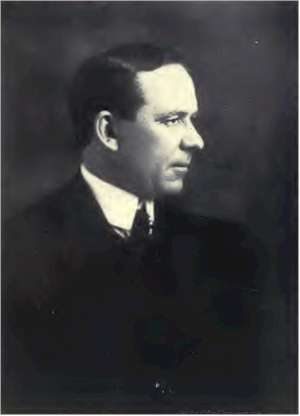
Jacking, Daniel C.
The position occupied in the mining
world by Mr. D. C. Jackling is unique, not only for the rather
brief period of time in which it has been attained, but because
in some respects it stands singularly alone. Most noted mining
men of the day owe recognition to their ability in determining
the existence and value of ore bodies and their relation to
mineralogical and geographical conditions. Mr. Jackling's
pre-eminence is due to his work in making commercially
profitable bodies of ore that at large would be deemed almost
worthless. In fact his success in this respect has been so
stupendous as to make the works directed by him unrivalled in
their kind. It may be said that the Utah Copper Company, because
of Mr. Jackling's metallurgical knowledge, covering the widest
and most practical grasp of the subject, was really the pioneer
in making commercially profitable the handling of large bodies
of copper ore of such low grade as had previously been looked
upon as almost waste. From a three hundred ton mill which he
erected for experimental purposes, one now handling eight
hundred tons is in operation in Bingham Canyon, and another one
with a capacity of seven thousand tons daily is running at
Garfield, in this county also. When the small quantity of copper
in the ore is considered, the vast tonnage of copper produced is
little less than marvelous.
Of the Utah Copper Company Mr.
Jackling is vice-president and general manager, as well as being
chairman of its executive committee. He holds a like position
with the Ray Consolidated Copper Company. The mines of the Ray
Consolidated Company, situated at Kelvin, Arizona, are not
unlike, in the ores they carry, those of the Utah Copper
Company, being low grade. The difficulty, however, has been the
distance from railroad transportation. Having knowledge of Mr.
Jackling's work in connection with the ores of the Utah Copper
Mines, and recognizing their similarity to those of the Ray
Consolidated Mines, the owners of the latter property naturally
turned to Mr. Jackling for his services in its development. That
work is now in progress, with the promise of results no less
remarkable (not alone in the profits to be made, but in the
magnitude of the production) than those of the Utah Copper
Company.
Mr. Jackling was born near Appleton
City, Missouri, in 1869. He is a son of Daniel Jackling, a
successful merchant, and Lydia Jane Dunn. He was educated in the
University of Missouri and the Missouri School of Mines, and
came to Utah from Colorado in January, 1896, shortly after being
married. His business activities have brought him into
prominence in many directions, but naturally the remarkable
success which followed his handling of the Utah Copper Company's
properties has won for him a recognition that is equaled by very
few men in any line. Besides his connection with the Utah Copper
Company and the Ray Consolidated Copper Company, he is a
director and heavy stockholder in the United States Sugar & Land
Company of Garden City, Kansas, in the Salt Lake Security &
Trust Company, in the Utah Fire Clay Company, and in the
Garfield Banking Company. He is also a director and member of
the executive committee of the Utah Hotel Company, and is
vice-chairman of the Utah Commission of the Alaska-Yukon-Pacific
Exposition.
While in Colorado Mr. Jackling served
two years on the staff of Governor James H. Peabody. In
selecting his official family recently, Governor Spry of this
State appointed Mr. Jackling general inspector of target
practice, with the rank of colonel. He is president of the Alta
Club, the oldest and most respected club in this city, a member
of the American Institute of Mining Engineers, a member of the
El Paso Club of Colorado Springs, of the Commercial Club of this
city, and of the Rocky Mountain Club of New York City.
In every respect Mr. Jackling is a
liberal, enterprising citizen. Had the last Mining Congress,
held in Pittsburg in 1908, given to Utah the headquarters for
the Congress, Mr. Jackling was pledged to raise $50,000 toward
the construction of the Mining Temple therefor.
Mr. Jackling is a man of broad views
and is mentally equipped far beyond the average. He has a truly
remarkable grasp of subjects (not confined to his special line)
in their relation to the interests of mankind generally. It is
difficult to imagine a vocation in life, or a calling, in which
Mr. Jackling, with his intellectual force, would not be
eminently successful. In this respect he is distinguished from
most notables, who are capable of doing only one thing very
well. Upon whatever subject the force of his mind is turned, a
clarity of vision is developed and a direction of energy that
assure successful results.
Mr. Jackling is a young man, and may
well be recognized and reckoned with as one of the potent forces
of our growing State, if not of the nation. With Mrs. Jackling
he resides in a commodious home at No. 731 East Brigham Street.
They have no children.
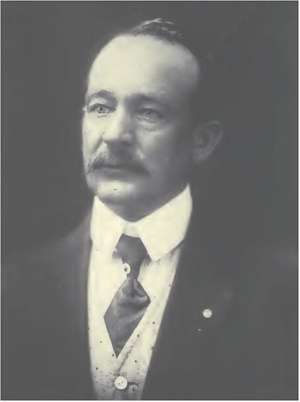
Jacabson, Alford O.
Of the numerous young men which Salt
Lake has given to the world, as leaders in the sphere of finance
and business, none is better known than Alford O. Jacobson. Born
in Salt Lake City in 1871, he has, perhaps, of all others
engaged in the mining industry, the proud right of saying that
he knows it from the bottom of the shaft to the gallows frame,
with all its allied branches.
Mr. Jacobson received his early
education at St. Mark's, but at the age of thirteen began
working in the mines which were just then beginning to attract
the attention of the world at large to Utah and its store of
precious metals.
Beginning his career at this early
age, he literally worked his way through all the gradations of
the industry, acquiring at each step a thorough knowledge of
that particular phase of the work, until he finally became
qualified through the hard school of experience, as one of the
best informed and experienced mining men of the country at
large.
Men with properties on their hands
which needed development at the hands of an expert were not slow
in learning of Mr. Jacobson's abilities, and many a despondent
stockholder has been raised from the depths of despair by the
information that A. O. Jacobson had taken charge of the property
in which he was interested.
From the moment that he entered the
mines as a boy, Mr. Jacobson has never deserted the field, and,
while improving and developing the properties of others, he has
not been slow to acquire interests of his own in properties
which he believes have a future in store for them. For twelve
years he has been identified with a number of propositions in
the Tintic District, while at the same time he has been the
superintendent of the Columbus Consolidated, at Alta. This mine
now has a well-equipped plant, but when Mr. Jacobson took
charge, it fell to his lot to set up and run the compressors and
sharpen his own drills. This he did until ore was reached, and
this unflagging zeal in the service of others is perhaps the
real secret of his success. At the present time he is not only
superintendent of the Columbus Consolidated, but of the Columbus
Extension, and is a director of the South Columbus.
Mr. Jacobson has served as a justice
of the peace in the Alta District with energy and efficiency.
Although not college-bred, he is an educated man of marked
intelligence and well abreast of the times. A man of honesty and
integrity of purpose, he is one of Utah's most useful citizens.
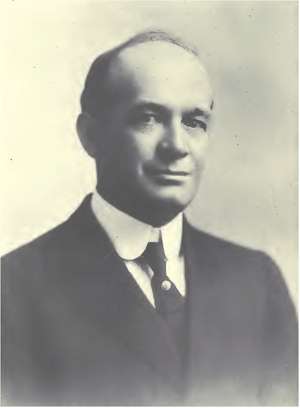
Jacobson, Tony
Columbus Consolidated Mining Company
Many years ago the Little Cottonwood
mining district of Utah, better known as Alta, was one of the
most generous ore-producing sections of the West. The little
camp lay hidden in precipitous mountains, and it was this fact
that killed the camp for a great many years after a record of
splendid merit. Snow slides cleaned the town out completely,
killing scores of people, and the desertion of the camp was
complete.
In 1902, Tony Jacobson, a practical
miner, prospected Alta thoroughly, and he discovered mineral in
such quantity that he determined to rejuvenate the camp, snow
slides or no snow slides. In April, 1902, he organized the
Columbus Consolidated Mining Company, interesting some of the
strongest banking talent of Salt Lake City in the company.
The property necessarily was
developed by means of tunnels, and the main tunnel has given a
great vertical depth on the resources. The ores occur on the
upper levels as lead-silver carbonates, and at depth these have
given way to the sulphides, while considerable gold and copper
values have entered the ores.
During 1907 the company began paying
dividends, distributing a total of $212,623.50 until a great
fault threw the resources into the un-probed heart of the
mountains. Since that time the management has been engaged in
developing still deeper into the hills, fighting against great
odds incident to an abundance of water on the lower levels and
the distance from railroad transportation. Early in 1909 the
elusive remainder of the known ore bodies were discovered, 400
feet below the main tunnel, and since that time the company has
been a regular contributor of ores to the Salt Lake smelters.
Dividends will in all probability be resumed during 1909.
The story of the Columbus
Consolidated Company illustrates the way in which man will fight
the elements to gain success. Mr. Jacob-son has had to contend
against bad camp history, yearly snow slides, steep mountain
roads, which prevent ore hauling during the winter months, and
many other difficulties which would have discouraged a less
persevering man. His efforts have succeeded in reviving the
district, and Alta today is looked upon as one of Utah's big
camps. Mr. Jacobson is general manager of the company. The
officials are: Chas. A. Walker, president; B. F. Chynoweth,
vice-president; S. A. Whitney, secretary and treasurer. Tony
Jacobson and Louis A. Jeffs complete the Board of Directors. The
property is one of the most thoroughly equipped in the State,
having its own milling plant at the tunnel mouth to treat the
ores not rich enough to ship without preliminary treatment.
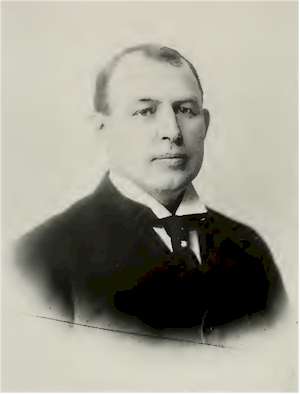
Jensen, Wiggo F.
One of the
most experienced creamery men and a recognized authority on
everything pertaining to dairying in the world is the subject of
this sketch. Mr. Jensen is a native of Germany, and was born at
Osterlinnet, Schleswig, November 28, 1871. He is a son of Jacob
Jensen, who was of Danish ancestry, and Marie Vieland Jensen.
The elder Jensen was a farmer, and also conducted a creamery.
Young Jensen decided to follow that vocation, and has risen to
become one of the leading creamery men in the country.
Wiggo F. Jensen was educated in the
Skebelund College, Wejen, Denmark, graduating in 1888. He then
went back to his father's creamery, where he remained until
1891. He then went to Denver, where he engaged in the produce
commission business until 1893. He then went to Superior,
Nebraska, and took charge of a creamery where he remained till
1895, going to Beloit, Kansas, where he remained for five years,
starting the Jensen Creamery Company. In the spring of 1900 Mr.
Jensen went to Topeka, Kansas, where he became vice-president of
the Continental Creamery Company, and later assumed the
presidency of the company, it being the largest creamery in the
world. During Mr. Jensen's residence in Topeka, Kansas, he, with
his brother, formed the Jensen Manufacturing Company,
manufacturers of dairy machinery, and the leading firm of the
kind in the United States. Mr. Jensen remained in Topeka until
the spring of 1908, when he removed to Salt Lake City, and
incorporated the Jensen Creamery Company, with the following
officers: W. F. Jensen, president; I. N. Parker, vice-president;
A. P. Henningsen, secretary and treasurer; with branches at
Pocatello, Idaho, the average output of both places being
3,000,000 pounds of butter per annum, with a capacity doubling
that amount. The entire product, including cream, eggs, cheese,
and poultry, is purchased from the farmers of Utah and Idaho. It
will be seen, therefore, that the Jensen Creamery Company is an
important element in the development of our resources and
industries. The business of the creamery extends throughout the
entire inter-mountain country, and to California, Oregon and
Washington. The company gives employment to nearly two hundred
men, and does a business of over a million dollars a year.
Mr. Jensen was married June 24, 1901,
to Matilda R. Brandt, of Kansas, and they have one son,
Ethelbert W. Jensen. Mr. Jensen is president of the Jensen
Creamery Company of Utah and Idaho, secretary and treasurer of
the Reno Creamery Company of Nevada, director of the Jensen
Manufacturing Company of Topeka, Kansas, and a director in the
Western Printing and Publishing Company of Topeka.
Mr. Jensen is a member of the
Commercial Club of Salt Lake City, and of the Commercial Club of
Topeka, and was its president at one time. He is also a member
of the B. P. 0. E., the Odd Fellows, the Masonic Fraternity, and
the Saturday Night Club of Topeka, Kansas. He resides at 1203
Third Avenue, Salt Lake City.
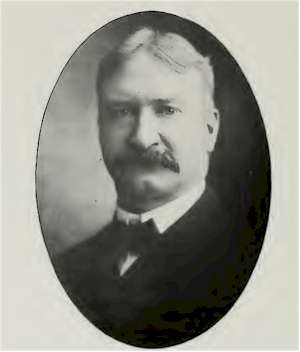
Joseph, Harry S.
One of the best-known mining men in
Utah, and in fact in the entire inter-mountain region, is Harry
Sheridan Joseph, who first saw the light of day in Cincinnati,
Ohio, June 14, 1866. His father was Solomon Joseph, a well-known
merchant of Cincinnati, and his mother Augusta Bamberger Joseph.
The young man received his earlier education in the public
schools of his native State, and later attended and graduated
from the University of Cincinnati, with degree of civil
engineer. Energetic, industrious and quick to learn, the young
man gave early promise of a successful career.
At a comparatively early age, he decided upon the West as a
field for future endeavor, and in 1887 he settled upon Utah,
arriving in Salt Lake on June 10th of that year. On February 21,
1894, he was married and since has occupied a handsome residence
where he frequently keeps open house for his friends at No. 80 H
Street. Up to 1893 Mr. Joseph was associated with Simon
Bamberger as chief engineer of the railroad and other
enterprises.
Mr. Joseph has since been actively engaged in mining, but his
versatile train-ing and wide knowledge of men and events soon
led him into public life, which held for him always a remarkable
attraction. He has held the position of county surveyor of Salt
Lake County and also of Davis County, has served two terms in
the Utah legislature, the last of which was concluded in 1907
with Mr. Joseph as speaker of the lower house. For some time
past he also has been president of the State Industrial School
Board and for a number of years past has been actively connected
with the Salt Lake Stock and Mining Exchange, as well as being a
member of the Elks Club, the Commercial Club and the recently
formed Ohio Society, in the last of which he is recognized as
one of the moving spirits.
In the mining world Mr. Joseph holds an enviable position for
his numerous signal successes in the face of difficulties which
might well have daunted a hardier spirit, among them being the
Carisa, Lower Mammoth and Beck Tunnel of the Tintic District.
Notable among the companies in which he is interested is the
Silver Shield Mining and Milling Company, a property which is
regarded as having one of the most promising futures of any mine
in Bingham. Located just south of the great United States Mine,
the same geological conditions which obtain in that well-known
producer are also apparent in the Silver Shield. Mr. Joseph is
heavily interested in a number of Park -City properties, as well
as in the Tintic District and Bingham, in addition to
controlling a number of valuable interests in the Yerington and
Goldfield districts of Nevada.
Up to now Mr. Joseph's efforts have been attended with marked
success, but there are those among his friends who do not
hesitate to predict for him an even greater future. Possessed of
a jovial, whole-souled manner and a disposition of which
generosity and public-spiritedness form the keynote, Mr. Joseph
is at once a witty and a clever conversationalist and a man of
experience and exceptional judgment.

Index

Source: Sketches of the Inter-Mountain
States, Utah, Idaho and Nevada, Published by The Salt Lake
Tribune, Salt Lake City, Utah, 1909
|

